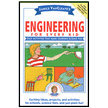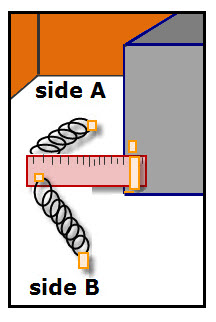 |
Janice VanCleave’s Engineering for Every Kid: Easy Activities That Make Learning Science Fun
This book contains research for different types of engineering as well as investigations that can be used as exploratory experiments in the design and developing of an engineering project. |
 Designing! Developing! Testing!
Designing! Developing! Testing!
Engineers often design scale-models of large projects, such as buildings, bridges, etc…
The development or building of the scale-models may gives engineers clues about construction problems.
When tested, these models can help identify problems that could be costly as well as unsafe for the life-size construction.
Not all models are scale-models. The function of some models, such as educational models, is to demonstrate how a specific phenomenon in nature works.
Engineering Fair Projects
Models can be designed, developed, and tested for an engineering fair project. For such a project, you need to follow specific guidelines, which are described on this page:
Engineering Method for Designing Engineering Projects
It is helpful to know the criteria for evaluating Engineering Fair Project.
How Engineer Projects Are Evaluated.
For a less complicated engineering project, the following information gives you ideas for developing a working model for the production of sound waves.
How To Get Started
To design a sound producing model, you have to know the science about sound waves and how they are produced. In other words, research sound waves, sound energy, production of sound waves, etc……
Facts:
I know that sound waves are produced when something vibrates (moves back and forth).
What do I have that easily vibrates?
A flexible, plastic ruler might work. I could tape one end of the ruler to something stationary, like a desk. The free end of the ruler will vibrate. I’ve done this before in other investigations, so I know this will work. But, I will replace the ruler if I find something that might work better.
When an object vibrates, it hits against the air molecules surround it. When the object moves one way, the object pushes the air molecules forward, compressing (squeezing them together). At the same time the air molecules on the opposite side spread out.
How can I represent air molecules on one side of the ruler being compressed, while the air molecules on the opposite of the ruler are spreading out?
Slinkies easily compress and stretch out. A Slinky on each side of the end of the ruler might work. But other end of each Slinky must be secured to the surface it is laying on.
Draft Diagram
The diagram shown above is how I visualize the connected materials. As I worked on the sketch for the model, I visualized I wanted to happen as each piece moved.
How is the proposed model suppose to work?
When the ruler is pulled toward side A:
The coils of Slinky-A, representing air molecules on side A, should compress (squeezes together).
The coils of Slinky-B, representing air molecules on side B, should spread apart.
When the ruler is pulled toward side B:
The coils of Slinky-B, representing air molecules on side B, should compress.
The coils of Slinky-A, representing air molecules on side A, should spread apart.
When the ruler is pulled toward one side and released:
The coils of the Slinkies, like air molecules surround a vibrating object, should continue to be compressed, and then spread out. As the air molecules next to the ruler compress and expand, they push on adjacent air molecules causing them to compress and then spread out, and so on.
Now the model needs to be built and tested.
What Happens If the Model Design Doesn’t Work?
This really depends –it may be a matter of adjusting the position of materials. Or, replace materials with something you think would work better.
If draft model is not salvageable, keep the design information as part of your journal for this modeling project and start over.
Will the design shown for producing sound waves really work? I cannot say because it is still on the drafting board–meaning I have dreamed up the design for the model, but have not constructed and tested it.
 |
Sticky, Gloppy, Wacky, and Wonderful Experiments
These experiments can give you the research information |